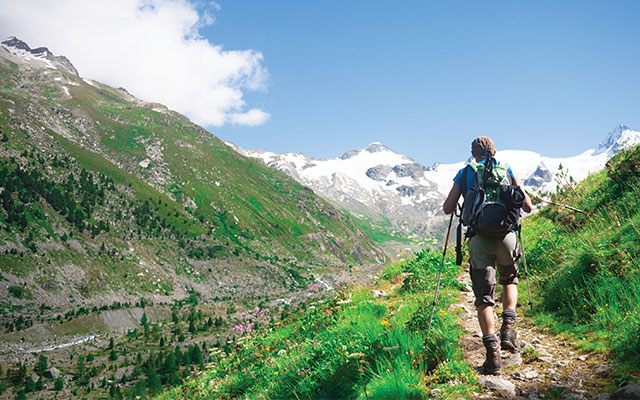Trail running is not just running off-road. By stepping out of your local concrete jungle and onto the varied terrain of the great outdoors, you can strengthen your body and your mind. Aficionados love the challenge of tackling dirt, rocks, roots, mud, sand, and more — all of which guarantee that they rarely have the same experience twice.
“A run on trails can take you up and down mountainsides, with rocky, rooted, sometimes muddy footing, or across desert or coastal landscapes, escaping the sights and sounds of urban life,” says longtime ultrarunner Sarah Lavender Smith, author of The Trail Runner’s Companion: A Step-by-Step Guide to Trail Running and Racing, from 5Ks to Ultras.
While providing a new perspective on nature, trail running also offers tremendous physical and mental benefits. “It’s easier on the body than road running, and you have a lower chance of most injuries because every footfall is different, depending on the terrain,” says Life Time trail-running coach Ryan Krol, who competes in Colorado’s Leadville Trail 100 Run event. “It’s also a great way to get out in nature and connect with a welcoming community,” he notes.
The range of terrain provides a full-body workout while benefiting our brains, which adapt to new experiences, adds Terry Chiplin, event director for the U.S. Trail Running Conference. Plus, it’s a natural meditation.
“Running on the trails is an opportunity to remind ourselves of the importance of being in the present. You have to be in the moment — focused — while also aware and connected with what is going on around you.”
More than 10 million Americans run off-road, nearly double the number from just five years ago. But the sport’s growing popularity belies the reality check that many — especially seasoned road-, track-, and treadmill-runners — face when they first take up trail running.
Since the pace for tackling hilly and technical terrain is generally slower than that for cruising along concrete, Smith suggests taking a step back from time expectations: A 9-minute miler on a paved road could easily turn into a 15-minute miler on the trail.
And be prepared for “downshifting” into power-hiking mode. “It’s OK to be slow,” she says.
It’s also important to budget more time and patience — and carry more hydration and nutrition, too, to handle the extra time on the trail.
Developing greater physical resilience and fitness will make the tradeoff of slowing down worth it in the long run.
Technique Tips & Drills
Adjust Your Gait
Your running style may naturally shift to suit the terrain. Take the following cues to fall into stride.
- Lean slightly forward and stay light on your feet.
- Practice a relaxed yet powerful arm swing, with your hands moving from hip to chest level.
- Engage your core and relax your shoulders.
- Shift your gaze closer in front of you than you would while running on a flat road.
- Stop occasionally to shake out your arms and legs.
- Adjust your pace, slowing to hike as needed to help maintain good form.
Be Present
Mindful running can enhance the trail experience, helping you tune in to your body and connect with your natural surroundings. Paying attention can also prevent injury. Try the following techniques on your next trail run.
- Center your thoughts on your breath. Notice how your inhalation and exhalation fit your foot-strike pattern.
- Pay close attention to the visual details. Imagine guiding a visually impaired runner: How would you describe the trail? Developing a narrative can enhance your awareness of your surroundings.
Stay Safe
The following safety precautions are worth the minimal time and effort.
- Tell someone where you’re going and when you plan to return.
- Confirm whether your selected trails are closed, require special gear, or are frequented by dangerous animals. Bring a map and a compass, a GPS device or app (such as GAIA, pictured below), or a navigation map, such as AllTrails.
- Carry enough food and fluids to sustain you if you’re on the trail longer than expected.
Drills
Drill 1: Stair Repeats
This workout will boost agility, strength, and cardio all at once, Smith says. Plus, the knee-lifting stride will train you for running hilly trails with tripping hazards.
- Find a nearby stadium (try a local school) or other structure with several flights of stairs.
- Run from the bottom of the stairs to the top, pumping your arms as if you were racing.
- Focus on lifting your knees and engaging your core to power the stride from your glutes and hamstrings as well as from your quads.
- Jog lightly back down the stairs.
- Start with one set once a week and work your way up to eight sets twice a week.
Drill 2: High Five
On the trail, you’re working in multiple planes of direction, moving laterally or lifting your legs higher than usual to go over rocks and branches or to just follow the zigzag of the trail.
Smith suggests practicing these five moves at least twice a week; work in one to four sets before or after a run.
- 30 seconds of high-knee skipping, swinging your arms high to the sky
- 30 seconds of grapevines
- 20 seconds of high knees
- 20 seconds of butt kickers
- 20 seconds of fast feet
Drill 3: Cadence, Cadence, Cadence
“Working on cadence — the number of times your feet land on the ground in a minute — is a great place to start for new trail runners,” says Chiplin. Experts have found that the magic number is around 180 for moving efficiently to avoid injury.
- Download an app, such as Run Tempo, that tracks cadence.
- Measure your current cadence and work toward gradually adjusting it to 180.
- Repeat for several runs, synchronizing your foot plants to the beat of the app. Take your time adjusting to a new cadence.




This Post Has 0 Comments